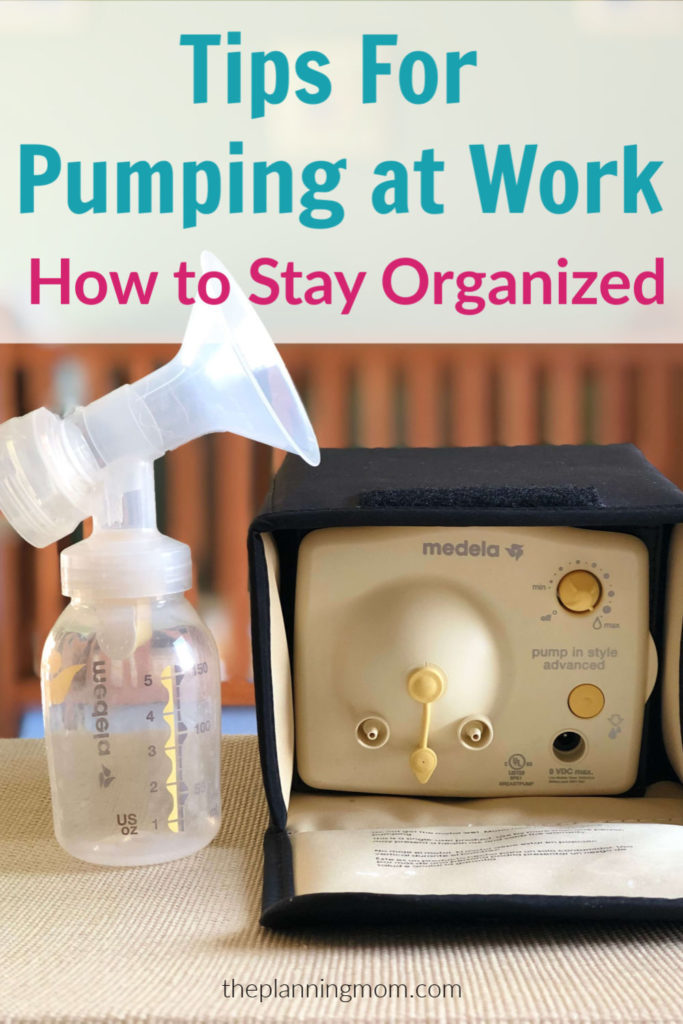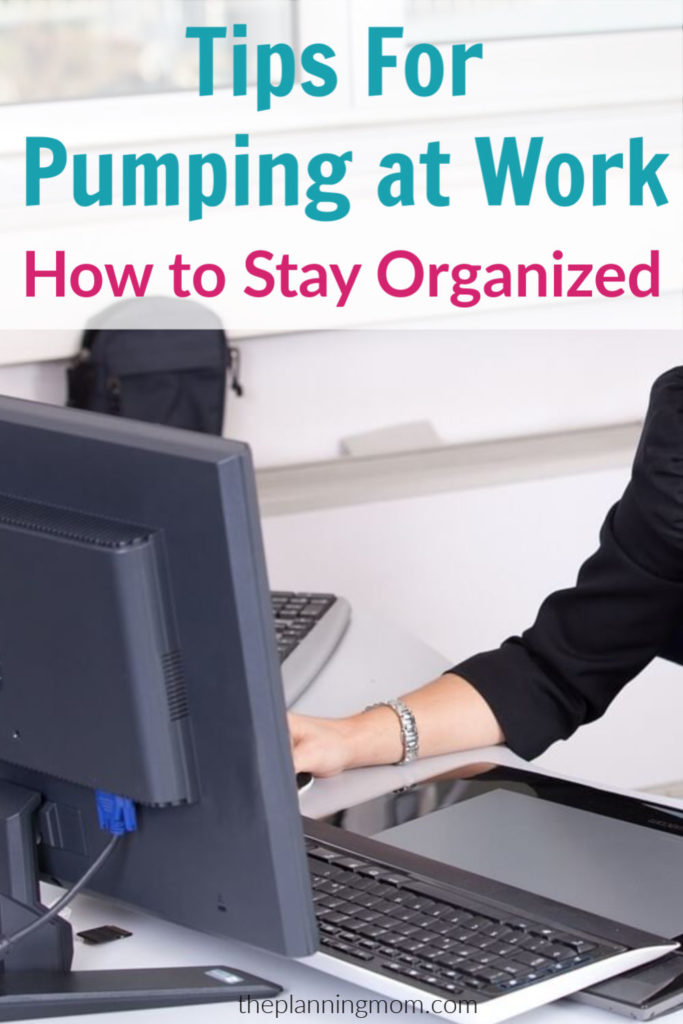Are you dreading going back to work after maternity leave and having to pump? You may have lots of questions and are curious how this is going to work. Put your mind at ease and get prepared with these tips for pumping at work.
Unsure if you want to breastfeed your baby? Do not let pumping at work determine your decision or stop you from breastfeeding. With some planning and preparation, pumping at work can be done and become part of your daily routine.

Benefits to Pumping at Work
If you choose to breastfeed your baby likely you will have to pump at work. There are many benefits to pumping at work like the following:
- Keeping up your milk supply
- Produce more milk volume for your baby
- Pumped milk is cheaper than using baby formula
- Sense of fulfillment – you are still providing for your baby while working
Challenges With Pumping at Work
There can be some challenges to figure out with pumping at work. It may take a couple days to feel comfortable and get into routine, but it can be done.
Finding a space
Each job is different when it comes to a good location of where to pump at work. Legally, a workplace has to provide a place for you to pump that is not a bathroom. The most ideal space is a secluded room or a private office with an outlet. In addition, a sink and fridge are bonuses to have in the room with you, but not necessary. You can always use a sink in a bathroom or kitchen for rinsing and washing parts. Also, if there is no fridge available, get some good ice packs and a mini cooler to keep the milk cold for the duration of the day.
Finding the Time
Depending on how long you pump or how often, it can be difficult to find time to pump at work. If your job is to be with customers, students or in meetings all day pumping time will have to be scheduled in. In addition, there may be potential loss of work time. If your job involves meeting a quota each day you may need to stay longer or work fast to make up time.
Keeping Track of Pumping parts
Pumping does involve some equipment and parts. First, the parts need to be kept clean and sanitary for each pump. Second, transferring equipment and parts to and from work can be a hassle. Lastly, keeping track of all the parts and the milk each day is a lot. Each day you have to remember to bring the milk and parts home and the next day bring them all back. Pumping at work is a real commitment.
Human Error
There may be some difficult days with pumping at work. Errors like forgetting to grab the pumped milk in the fridge or failing to bring a part, or a part breaks while at work are bound to happen. We are human and likely sleep deprived, so errors will occur from time to time.
Although, any time you get frustrated with pumping at work, think about the benefits you are providing your baby. Furthermore, this is not a long term thing. Depending on how long you plan to pump, this will only last a few months to a year. You can do it!
Prepare for Pumping at Work
Now that you know the challenges with pumping at work, make a plan to overcome these challenges. If you plan to pump at work, before baby arrives, get prepared as much as possible. If your baby is already here, no worries. There is a lot you can do to prepare while on maternity leave. Here are tips for how to stay organized and make pumping at work easier.

Get More Equipment and Parts
Pumps
If you are pumping at both work and at home, ideally it would be nice to have two pumps. Personally, I prefer electric pumps over manual because they are faster and less hands on work. But you need to do what works best for you. First, while you are pregnant, add to your baby to do checklist to contact your health insurance if they provide a free pump. They may have a small selection of the kind you may get, but take a free pump if it is offered.
In addition, your health insurance may offer a free pump each time you have a baby. So if you are having your second or third child, you can get another pump. Take advantage of this! Pumps get old and wear out. When I had my first baby, I got a free pump from my insurance and borrowed the same kind from a friend so I could have one at home and one at work. Then when I was preparing for my second baby, I got another free pump from insurance just in case one of the others stopped working. It is a good thing I did, because the second day I used the one pump it stopped working. So I had a back up pump to slip into place at work so I could still keep one pump at home and one at work.
Pumps are expensive running between $100 – $400. So instead of purchasing a 2nd pump check with friends and family who recently finished breast feeding to see if you can borrow or buy their pump and pumping parts at a discount.
Pumping Parts
Having extra pumping parts makes pumping at work much easier. It is ideal if you do not have to transfer all your parts to and from work each day or wash and dry your parts after each pump.
Next, you will need more pumping bottles (the bottle the pumped milk drops into) than the two that typically come with a pump. At least 4 or 6 are necessary unless after each pump you pour the milk into another container.
To save yourself time, get enough parts for each pump at work. Also, get enough parts to keep some at work and some at home if you are pumping at both places. This way you do not have to transfer all your parts back and forth each day.
Pumping Bra
If you want your hands free while you pump get a pumping bra. This was a necessity for me and I wore it every time I pumped. At work I wore it because I could respond to emails and type while pumping, so my work didn’t have to stop. Also, while I was pumping I wanted to check in on my baby or look at my recent baby photos to feel a connection with my baby while I was at work. In addition, I wore a pumping bra when I pumped during the night at home so could check my phone and not hold the pumps.
Stick to a Schedule and Routine
Next, when you are pumping at work, stick to a schedule so people know the times you are unavailable. Make pumping at work a priority and part of your daily routine. Others will understand and respect that your baby comes first.
Also, sticking to a schedule will keep your supply up and you are less likely to skip a pump. Figure out a schedule that works in accordance to when you last fed your baby and when you will feed him/her again after work. Some say to pump when you normally would feed your baby. However for me, my baby was not on a set schedule so I pumped 3 times a day at work about 2.5 – 3 hours apart. I did make sure to pump enough time before I left so I had enough supply to feed my baby when I got home. They always seemed to want to eat (and bond) when we got home from work and daycare.
Create a System
To help remember everything like taking my milk home, taking parts home to sanitize, and bringing parts back I had to come up with a system. I created the good and bad bag system. I used 2 gallon zip lock bags. One I labeled in big letters bad and one good. So each day when I was leaving work I would put the parts that needed to be washed or sanitized in the bad/dirty bag. Then the next day I would bring them back to work in the good/clean bag.
After a few weeks the bad bag got kind of gross so I would toss that bag and make my good bag bad, and use a fresh new bag for the good/clean parts.
Furthermore, I had a system for when and how the pumped milk was used. When I got home, I put the fresh pumped milk from that day behind any bottles from previous days. This way when my husband made the bottles for daycare the next day he was using the oldest milk first.
There was a few months when I was pumping more than my baby needed. During these months on Thursday and Friday at work instead of leaving milk in the bottles after pumping I would pour the milk into freezer milk bags made especially for pumped breast milk. These came in handy when my supply decreased months later.
Final Thoughts on Pumping at Work
When you begin pumping at work, initially you may feel overwhelmed and unsure if you want to continue. Like most new things, it is not easy. However, if you stay organized and stick to your routine, you will figure out what works best for you and it will become the norm.
For more on how to prepare yourself for life with a baby check out my Ultimate Baby Planning Guide. Grab your free 30 item baby planning checklist below.
Related Posts:
- 5 Tips to Prepare for Breastfeeding While Pregnant
- How to Manage Your Time Well With a Baby
- 10 Things to Know to Prepare Yourself For Life With a Baby
- Best Mom Advice That I Ever Received
- 12 Household Items to Use as Baby Toys
- Best Newborn Gifts That Parents Will Love
- 15 Things to Expect After Having a Baby
- What to Expect Going Back to Work After Maternity Leave & Ways to Cope
Leave a Reply